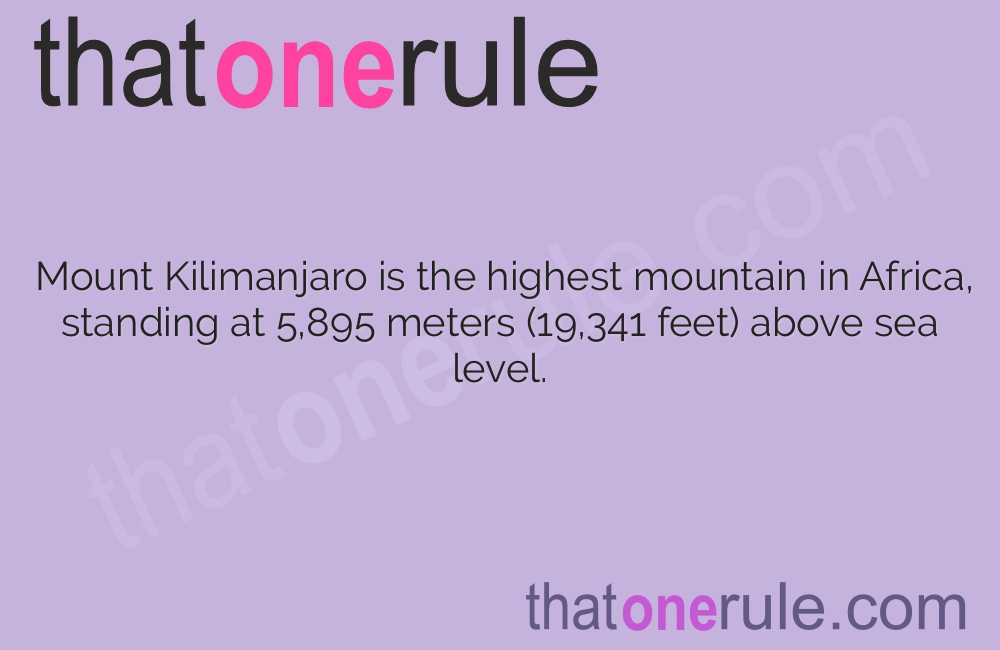

Mount Kilimanjaro is the highest mountain in Africa, standing at 5,895 meters (19,341 feet) above sea level.
Mount Kilimanjaro is the highest mountain in Africa, standing at 5,895 meters (19,341 feet) above sea level.
The mountain is a dormant volcano, with its last eruption occurring about 200 years ago.
Mount Kilimanjaro is located in Tanzania and is part of Kilimanjaro National Park.
It is one of the Seven Summits, which are the highest peaks on each of the seven continents.
More than 50,000 people attempt to climb Mount Kilimanjaro every year.
The mountain has three volcanic cones: Kibo, Mawenzi, and Shira.
Kibo is the highest of the three cones and is the ultimate destination for most climbers.
Mount Kilimanjaro is home to a unique ecosystem, ranging from tropical rainforests to arctic-like conditions at the summit.
The mountain is known for its diverse wildlife, including elephants, buffalos, and colobus monkeys.
Climbing Mount Kilimanjaro is considered a significant personal and physical challenge.
The first successful climb of Mount Kilimanjaro was made in 1889 by Hans Meyer and Ludwig Purtscheller.
The mountain offers various climbing routes, including the Marangu, Machame, and Lemosho routes.
Climbers may suffer from altitude sickness due to the rapid ascent to high altitudes.
The summit of Mount Kilimanjaro is covered in snow, despite being near the equator.
The glaciers on Mount Kilimanjaro have been shrinking due to global climate change.
The mountain provides stunning views, especially during sunrise and sunset.
Mount Kilimanjaro has been a source of inspiration for many artists and writers.
The ascent to the summit of Mount Kilimanjaro usually takes 5-7 days, allowing for acclimatization.
It is possible to spot the neighboring Mount Meru from certain points on the mountain.
Mount Kilimanjaro attracts adventurers from all over the world, contributing to the local economy.
The mountain has different climate zones, starting from a lush rainforest and ending in an alpine desert.
The lower slopes of Mount Kilimanjaro are home to various indigenous tribes, such as the Chagga people.
The Chagga people consider Mount Kilimanjaro as a sacred place and have various cultural rituals associated with it.
The mountain is a UNESCO World Heritage site, recognized for its natural and cultural importance.
The average success rate for summiting Mount Kilimanjaro ranges from 60-70%.
Despite being a challenging climb, no technical climbing skills are required to reach the summit.
The mountain’s highest peak, Uhuru, translates to freedom in Swahili.
Mount Kilimanjaro attracts philanthropic climbers who raise funds for various charities.
The mountain offers stunning panoramic views of the surrounding plains and national parks.
Local guides, known as Kilimanjaro porters, play a vital role in supporting climbers during their ascent.
Mount Kilimanjaro serves as a water catchment area, providing water for nearby communities.
Climbing Mount Kilimanjaro is an adventurous way to experience the beauty of East Africa.
The mountain has been featured in numerous films and documentaries, showcasing its grandeur.
Mount Kilimanjaro is a popular destination for solo travelers seeking personal growth and introspection.
The Kilimanjaro region is rich in cultural heritage, with various traditional crafts and music.
Mount Kilimanjaro has inspired numerous scientific studies on high-altitude physiology.
The mountainscape changes dramatically as climbers ascend, offering a dynamic visual experience.
The biodiversity of the mountain includes over 140 species of birds and various endemic plant species.
Kilimanjaro’s unique geology has drawn the interest of geologists and volcanologists worldwide.
The mountain’s slopes are home to different species of antelope, including the rare and elusive Abbot’s duiker.
Climbing Mount Kilimanjaro requires careful planning and preparation to ensure a safe and successful ascent.
The mountain has become a symbol of ambition, perseverance, and the pursuit of personal goals.
Mount Kilimanjaro provides an escape from the hustle and bustle of everyday life, offering a serene and tranquil environment.
The diversity of ecosystems on the mountain makes it an important center for scientific research and conservation efforts.
Mount Kilimanjaro serves as a majestic backdrop to Tanzania’s vibrant culture, blending nature and heritage in a captivating way.
Around the world, coffee enthusiasts enjoy Monin coffee concentrate since it is a multipurpose product. Conveniently combining…
The Importance of Choosing the Right Shower for Your Bathroom Renovating your bathroom can be…
Usain Bolt holds the record for the fastest 100-meter sprint in history.Bolt was named Sportsman…
Love is in the air... and it smells suspiciously like chocolate!Roses are red, violets are…
Life's a beach, take a picture and relax.Sun, sand, and salty kisses. That's what beach…
Hungary is home to the largest thermal water cave system in the world.The Rubik's Cube…